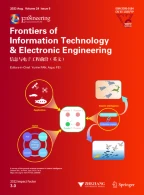Abstract
The introduction of proportional-integral-derivative (PID) controllers into cooperative collision avoidance systems (CCASs) has been hindered by difficulties in their optimization and by a lack of study of their effects on vehicle driving stability, comfort, and fuel economy. In this paper, we propose a method to optimize PID controllers using an improved particle swarm optimization (PSO) algorithm, and to better manipulate cooperative collision avoidance with other vehicles. First, we use PRESCAN and MATLAB/Simulink to conduct a united simulation, which constructs a CCAS composed of a PID controller, maneuver strategy judging modules, and a path planning module. Then we apply the improved PSO algorithm to optimize the PID controller based on the dynamic vehicle data obtained. Finally, we perform a simulation test of performance before and after the optimization of the PID controller, in which vehicles equipped with a CCAS undertake deceleration driving and steering under the two states of low speed (≤50 km/h) and high speed (≥100 km/h) cruising. The results show that the PID controller optimized using the proposed method can achieve not only the basic functions of a CCAS, but also improvements in vehicle dynamic stability, riding comfort, and fuel economy.
Similar content being viewed by others
References
CAN Newsletter Online, 2014. Emergency Steering Assist. http://can-newsletter.org/engineering/engineering-miscel laneous/140813_emergency-steering-assist
Chen, L.W., Chou, P.C., 2013. A lane-level cooperative collision avoidance system based on vehicular sensor networks. 19th Annual Int. Conf. on Mobile Computing & Networking, p.131–134. https://doi.org/10.1145/2500423.2505293
Cho, H., Kim, B., 2014. Cooperative intersection collisionwarning system based on vehicle-to-vehicle communication. Contemp. Eng. Sci., 7(22):1147–1154. https://doi.org/10.12988/ces.2014.49143
Feng, Y.Q., Ji, H.Q., Liu, Z.S., 2012. Parameter setting and simulation of the PID controller for vehicle spacing control system. China Sci. Technol. Inform., 2012(8):141–143 (in Chinese).
Huang, C.M., Lin, S.Y., 2014. Cooperative vehicle collision warning system using the vector-based approach with dedicated short range communication data transmission. IET Intell. Transp. Syst., 8(2):124–134. https://doi.org/10.1049/iet-its.2012.0101
Jin, C., Wang, J., Ma, J., et al., 2010. Application of improved PSO for parameter tuning of PID controller. J. Electron. Meas. Instrum., 24(2):141–146. https://doi.org/10.3724/SP.J.1187.2010.00141
Khan, H., Iqbal, J., Baizid, K., et al., 2015. Longitudinal and lateral slip control of autonomous wheeled mobile robot for trajectory tracking. Front. Inform. Technol. Electron. Eng., 16(2):166–172. https://doi.org/10.1631/FITEE.1400183
Kim, K.I., Guan, H., Wang, B., et al., 2016. Active steering control strategy for articulated vehicles. Front. Inform. Technol. Electron. Eng., 17(6):576–586. https://doi.org/10.1631/FITEE.1500211
Konstantinidis, E.I., Patoulidis, G.I., Vandikas, I.N., et al., 2010. Development of a collaborative vehicle collision avoidance system. IEEE Intelligent Vehicles Symp., p.1066–1071. https://doi.org/10.1109/IVS.2010.5548022
Kreuzen, C., 2012. Cooperative Adaptive cruise control using information from multiple predecessors in combination with MPC. MS Thesis, Delft University of Technology, Delft, the Netherlands.
Lee, D.H., Bai, S.N., Kim, T.W., et al., 2010. Enhanced selective forwarding scheme for alert message propagation in VANETs. Int. Conf. on Information Science and Applications, p.1–9. https://doi.org/10.1109/ICISA.2010.5480516
Mirfakhraie, T., He, Y., Liscano, R., 2014. Wireless networked control for active trailer steering systems of articulated vehicles. ASME Int. Mechanical Engineering Congress and Exposition, Volume 12: Transportation Systems, p.V012T15A003. https://doi.org/10.1115/IMECE2014-36440
Ong, H.Y., Gerdes, J.C., 2015. Cooperative collision avoidance via proximal message passing. American Control Conf., p.4124–4130. https://doi.org/10.1109/ACC.2015.7171976
Seo, H.S., Jung, J.S., Lee, S.S., 2014. Network performance analysis and manuever model for overtaking assistant service using wave. Int. J. Autom. Technol., 15(1):57–64. https://doi.org/10.1007/s12239-014-0006-x
Shi, Y., Eberhart, R., 1998. A modified particle swarm optimizer. IEEE Int. Conf. on Evolutionary Computation, p.69–73. https://doi.org/10.1109/ICEC.1998.699146
Shi, Y., Eberhart, R.C., 2001. Fuzzy adaptive particle swarm optimization. Congress on Evolutionary Computation, p.101–106. https://doi.org/10.1109/CEC.2001.934377
Solyom, S., Bengtsson, M., 2012. Collision Avoidance System in a Vehicle. US Patent 8 200 420.
Tan, H.S., Huang, J., 2006. DGPS-based vehicle-to-vehicle cooperative collision warning: engineering feasibility viewpoints. IEEE Trans. Intell. Transp. Syst., 7(4):415–428. https://doi.org/10.1109/TITS.2006.883938
Wang, Q., Phillips, C., 2013. Cooperative collision avoidance for multi-vehicle systems using reinforcement learning. 18th Int. Conf. on Methods & Models in Automation & Robotics, p.98–102. https://doi.org/10.1109/MMAR.2013.6669888
Wang, Q., Zhu, S., He, Y., 2015. Model reference adaptive control for active trailer steering of articulated heavy vehicles. SAE Technical Papers, 2015-01-1495. https://doi.org/10.4271/2015-01-1495
Wang, Q.G., Zou, B., Lee, T.H., et al., 1997. Auto-tuning of multivariable PID controllers from decentralized relay feedback. Automatica, 33(3):319–330. https://doi.org/10.1016/S0005-1098(96)00177-X
Wu, Y.H., Lu, Y.P., 2009. Main factors and evaluation methods of driving comfort. Heilongjiang Jiaotong Keji, 2009(8): 197–198 (in Chinese). https://doi.org/10.16402/j.cnki.issn1008-3383.2009.08. 107
Yan, G., Yang, W., Weigle, M.C., et al., 2010. Cooperative collision warning through mobility and probability prediction. IEEE Intelligent Vehicles Symp., p.1172–1177. https://doi.org/10.1109/IVS.2010.5547990
Yu, C.B., Wang, Y.Q., Shao, J.L., 2016. Optimization of formation for multi-agent systems based on LQR. Front. Inform. Technol. Electron. Eng., 17(2):96–109. https://doi.org/10.1631/FITEE.1500490
Zardosht, B., Beauchemin, S., Bauer, M.A., 2013. A decision making module for cooperative collision warning systems using vehicular ad-hoc networks. 16th Int. IEEE Conf. on Intelligent Transportation Systems, p.1743–1749. https://doi.org/10.1109/ITSC.2013.6728481
Zhang, H.T., Hu, H.L., Wang, B., 2008. A modified PSO algorithm and its application in tuning of PID. Techn. Autom. Appl., 27(12):14–16. https://doi.org/10.3969/j.issn.1003-7241.2008.12.004
Zhang, J.M., Li, Q., Cheng N., et al., 2013. Nonlinear path-following method for fixed-wing unmanned aerial vehicles. J. Zhejiang Univ.-Sci. C (Comput. & Electron.), 14(2):125–132. https://doi.org/10.1631/jzus.C1200195
Zhang, M.H., Duan, D.P., Chen, L., 2012. Turning mechanism and composite control of stratospheric airships. J. Zhejiang Univ.-Sci. C (Comput. & Electron.), 13(11): 859–865. https://doi.org/10.1631/jzus.C1200084
Zhu, X., Liu, Z., Li, L., 2015. Evasive manoeuvre for emergency steering based on typical vehicle-pedestrian use case. J. Autom. Safety Energy, 6(3):217–223 (in Chinese). https://doi.org/10.3969/j.issn.1674-8484.2015.03.003
Author information
Authors and Affiliations
Corresponding author
Additional information
Project supported by the National Natural Science Foundation of China (No. 61300145)
Rights and permissions
About this article
Cite this article
Wu, Xc., Qin, Gh., Sun, Mh. et al. Using improved particle swarm optimization to tune PID controllers in cooperative collision avoidance systems. Frontiers Inf Technol Electronic Eng 18, 1385–1395 (2017). https://doi.org/10.1631/FITEE.1601427
Received:
Accepted:
Published:
Issue Date:
DOI: https://doi.org/10.1631/FITEE.1601427
Key words
- Cooperative collision avoidance system (CCAS)
- Improved particle swarm optimization (PSO)
- PID controller
- Vehicle comfort
- Fuel economy
